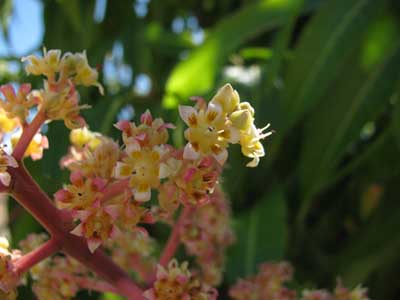Mangoes promise a productive future for the Territory

From 2019 to 2020, the total value of agricultural output in the Northern Territory was $1.265 billion. Mango, with a gross value of $67 million, was the largest commodity produced after livestock. It accounted for nearly 50% of the total value of Territory crops (source: Australian Bureau of Statistics).
To maximise the profitability of this valuable commodity, the Department of Industry, Tourism and Trade has always been involved in mango research and extension.
On the market side, more than half the mango production in Australia is from the Territory. Of the national production:
- 85% goes for fresh domestic consumption
- 5% for processing, and
- nearly 11% for export to countries such as Hong Kong, Singapore, New Zealand, UAE, and Saudi Arabia.
Mangoes are imported from other countries such as Thailand, Vietnam, Mexico, Brazil and India. However, Australia has remained a net exporter of fresh mango over the last six years (source: Australian horticulture statistics handbook).
The global consumption of mangoes is rising, with data from 2020 indicating an increase of 7.7% in the total global import quantity of fresh mangoes, mangosteens and guavas (source: Food and Agriculture Organization of the United Nations 2020) offering an interesting possibility for the Territory mango producers. Although the domestic supply for mangoes has decreased by about 6% in Australia, the fresh export value has increased by 10%.
No part of the fruit is wasted! Mangoes can be utilised at every stage of growth. The raw fruits are used for products like pickles, mango sauce, raw mango powder, and green mango beverage. Ripe fruits are used to make pulp, juice, nectar, squash, mango leather, frozen and canned slices, jam, ready-to-serve beverages, mango puree, mango cereal flakes, mango powder, mango toffee, and mango fruit bars.
The department’s recent projects include collaboration with federal and state research and development organisations for the development and commercialisation of the new National Mango Breeding Program (NMBP) varieties. These new varieties are high yielding, have a range of production timing and attractive appearance.
Over recent years, the department has produced thousands of plants of the new varieties to plant a hedge garden at our Coastal Plains Research Farm (CPRF) and Katherine Research Station (KRS) in an attempt to make these varieties more accessible to the industry.
A long-term trial is being conducted at KRS for evaluation of the NMBP varieties grafted on 6 different rootstocks. New projects have been initiated to explore the production potential of the NMBP varieties in a range of geographical locations all over the Territory.
With the Territory’s commercial mango farms, the department is implementing multi-stakeholder projects on yield forecasting at the time of flowering to:
- better align the harvest and logistics in the supply chain
- develop best practice recommendations for nutrition, irrigation, pruning, and disease management
- determine water use efficiency of the commercial mango varieties.
The department’s work in 2021 also involved assessing the post-harvest quality and shelf life of a new mango variety, including the varietal response to commercial vapour heat treatment. These efforts are being made to improve the efficiency of Territory-grown mangoes in the supply chain and to deliver:
- predictable quality to domestic and international consumers
- the continuation of the Mango Best Practice Project to provide information to growers
- early-stage mango dieback research focusing on the potential modes of transmission.
Mango is an important crop for the Territory and it features in many of our current projects and plans. The department is exploring even more opportunities to make the mango industry more prosperous for all stakeholders during 2022 and beyond.
More information
Read more information about the department’s current partnerships and research activities with mango growers.
